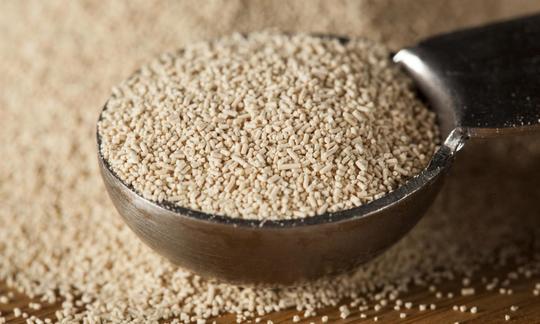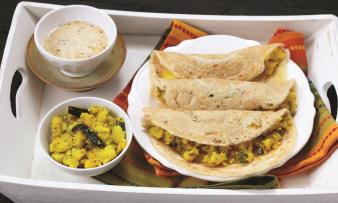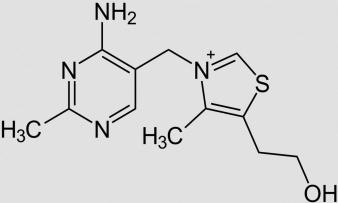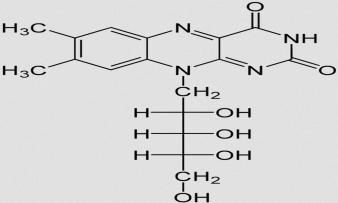Table of contents
Baker's yeast ( baker 's yeast , active dry yeast ), like brewer's yeast, comes from the Saccharomyces cerevisiae strain. Unlike fresh yeast, dry yeast does not need to be dissolved in water or pre-fermented. Yeasts produce carbon dioxide, which increases the volume of the dough and makes it taste light and airy.
Use in the kitchen:
What is active dry yeast? Dry baker's yeast is a biological leavening agent and can be used in the kitchen in a similar way to fresh yeast. To make dry yeast (Bärme), most of the water contained in the yeast is removed, which temporarily inactivates the yeast cells but does not kill them. This type of dry yeast can be reactivated if necessary, which is why it is called active dry yeast. 13
Dry yeast is usually packaged in sachets of around 7 g. This amount is enough for around 500 g of flour, similar to half a cube of fresh yeast. However, the amounts can vary depending on the recipe. For longer fermentation times, the amount of yeast can be reduced significantly.
With active dry yeast you can make fine pastries from wheat flour such as Striezel (Stollen, plaited bread, yeast cake), pizza bases, bread and rolls. You can also use yeast dough for fruit cakes, snails (or other figures), stick bread, Buchteln, waffles etc.
Can you mix dry yeast? If you mix dry yeast carefully in warm water, it will rise a little faster, but the baking process will still work without dissolving it.
As an alternative to wheat flour, you can also use spelt flour , and a whole grain portion is also possible. However, rye flour cannot be "raised" with yeast alone. Rye flour requires acid, which is found in sourdough in the form of lactic acid or acetic acid.
Types of yeast and their use:
When it comes to use in baking, fresh yeast (compressed yeast, baker's yeast) and baker's yeast (active dry yeast) are the main options. While fresh yeast is characterized by a stronger leavening power and is therefore well suited for baking preparations with long fermentation times (or several resting phases), dry yeast scores points for its durability and ease of use (dosage, mixability, etc.).
In addition to being used as a natural baking agent, yeast fungi are also used as a food supplement or seasoning due to their high content of glutamic acid and B vitamins - as is the case with yeast flakes (noble yeast ). However, as noble yeast is an inactive form of yeast (killed yeast cells 14 ), it can no longer be used for baking. These fungi can also be found in highly concentrated form and as a spread in the form of yeast-based spice pastes - a very intensely flavored yeast extract made from lysed yeast cells (produced by cell wall destruction).
Brewer's yeast , originally used in beer production, strikes a balance between being a leavening agent, food supplement, cosmetic product and intestinal flora sanitizer - depending on the processing (active, inactivated, etc.) in which it is used or consumed.
Baking powder is also a leavening agent that loosens the dough and raises it with the help of CO 2 . This chemical process (loosening) does not require a resting phase. The moisture added to the dough and the heat in the oven cause the CO 2 source ( sodium hydrogen carbonate or baking soda ) to react immediately with the acidifier contained (acid carriers can be, for example, disodium dihydrogen diphosphate E 450a or monocalcium orthophosphate E 341a). A release agent made of starch binds the moisture and prevents premature CO 2 development. The gas bubbles that form raise the dough and it acquires a loose consistency. The function of cream of tartar baking powder is the same, only the acid comes from a natural source: cream of tartar (e.g. from sparkling wine production).
Recipe for vegan cinnamon rolls:
Ingredients for approx. 10 cinnamon rolls: 2 1/4 teaspoons dry yeast (Bärme), 240 ml almond milk (or any other plant milk), 42 g vegetable margarine , 410 g spelt flour, 12 g raw cane sugar (or coconut blossom sugar ), 1/4 teaspoon salt .
For the filling: 42 g margarine, 50 g raw cane sugar, 2 tsp cinnamon .
Slowly melt the margarine in a small saucepan. Meanwhile, put the dry yeast in a large bowl and pour over the liquid margarine and almond milk. Stir until the yeast has dissolved (this also works in a food processor). Add 1 tablespoon of sugar and the salt and stir briefly. Then add the flour and knead the dough for about 1 minute until it is smooth. Form the dough into a ball and place it in a floured bowl. Cover with a kitchen towel and leave to rest at warm room temperature for about 1 hour.
Then preheat the oven to 175 °C and grease a baking pan measuring approx. 20x20 cm. After the resting period, knead the dough again briefly by hand on a floured work surface and roll it out into a square. Spread the melted margarine for the filling over the dough with a brush and sprinkle with sugar and cinnamon. Now roll up the dough and cut it into pieces approx. 5 cm wide with a knife. Place in the baking pan with the cut edge facing upwards. Optionally, you can brush the "snails" again with melted butter. Now bake the pan in the oven for approx. 25-30 minutes.
If you like, you can decorate the cinnamon rolls with a sugar glaze (made from 112 g powdered sugar and 15 ml almond milk) after they have cooled down.
| Not only vegans or vegetarians should read this: Vegans often eat unhealthily. Avoidable nutritional errors . |
Shopping - where to buy active dry yeast?
Active dry yeast is available at all supermarket chains such as Coop , Migros , Denner , Volg , Spar , Aldi , Lidl , Rewe , Edeka , Hofer etc., usually in small, hermetically sealed portion bags.
Organic dry yeast: Since 2009, the production of yeast has been subject to the EC organic regulation. Since then, organic baking yeast has also been available for purchase. In contrast to conventional yeast, organic yeast is always grown on non-GMO raw materials (molasses or grain). Since the raw material is usually grain mash due to a shortage of organic molasses, you first have to get used to the changed taste and also change to a slightly different handling. In addition, organic yeast must not contain any synthetic additives, such as nitrogen and phosphorus sources or synthetic vitamins. Only sunflower oil is permitted as an emulsifier for defoaming. 1
The higher price of organic yeasts can be explained by the slower growth, the higher raw material requirements and the lower yield. 2
Making your own dry yeast:
If you don't want to use industrial yeast, you can make your own liquid, wild yeast - or rather cultivate and multiply it. Some people tolerate this yeast better than that from the supermarket. Yeasts are small fungi that need nutrients like sugar to convert it into carbon dioxide and alcohol. Even though yeasts are living organisms, they are considered vegan foods because they do not have a central nervous system. The yeast strain most commonly used in nutrition , Saccharomyces cerevisiae, is found in many types of fruit. Dried fruit is therefore an ideal breeding ground for starting your own yeast culture.
It is important to use unsulphured fruits, such as plums, dates or apricots. You also need 1 tablespoon of sugar and 500 ml of lukewarm water. A narrow, tall glass is ideal as a container (e.g. a screw-top jar) to keep the water surface to a minimum for any unwanted bacteria. Shake the water and sugar vigorously in the closed jar so that the sugar dissolves. Then add 2 dates (or other dried fruit) to the water. Leave the whole thing in a warm place at around 25-35 °C and shake the yeast water vigorously once every morning and every evening. It is important to open the container afterwards so that the excess gases can escape.
After about 5-10 days, the active yeast is ready. You can tell this by the typical yeast-like smell, the cream-colored yeast that has settled on the bottom and the bubbles that have formed in the water. The white streaks in the glass are from the softened dried fruit and are not mold. However, if mold is clearly forming, the yeast water should be thrown away immediately!
Homemade yeast is ideal for recipes that require a pre-dough. The longer and more frequent rising times (eg yeast plaited bread) give the wild yeast enough time to rise. The well-shaken yeast water is used instead of the liquid in the recipe. The dried fruit should be discarded.
To multiply the active yeast again, leave 150-200 ml of yeast water in the container, add 2 fresh dried fruits and 1 tablespoon of sugar and refill with lukewarm water. Now the yeast only needs 2-3 days after shaking and opening twice a day.
If you do not want to reproduce the active yeast immediately, you can store the remaining 200 ml of yeast water in the refrigerator for 1-2 weeks. The cool temperatures slow down the fermentation process. 3
Storage:
Active baker's yeast can be stored for a good year at dry room temperature. However, in addition to the expiration date, you should also make sure that the package is well sealed - or that you close it again after opening. Otherwise, the moisture will reactivate the yeast cells, which will cause them to lose their function.
Ingredients - nutritional value - calories:
Baker's yeast is particularly rich in proteins (approx. 35-45 g/100g yeast) and fiber (25-30 g/100g yeast). The fat content is comparatively low at 7.6 g/100g. 4
Dry yeast contains a lot of folate : 2,340 µg/100g. However, it is important to pay attention to the amount used - for 500 g of flour you need about 7 g of dry yeast! The folic acid content of fine yeast is 300 µg/100g, although the more frequent use and the larger quantities consumed put this value into perspective. Folic acid is very important for cell renewal, protein metabolism and the development of the fetus. The daily requirement of an average adult is about 300 µg, pregnant women need significantly more at 550 µg daily. 5 Good sources of folic acid are pulses (e.g. cooked lentils : 181 µg/100g) and green vegetables (e.g. kale : 141 µg/100g or spinach : 194 µg/100g). 4
Yeasts contain many important B vitamins such as thiamine ( vitamin B 1 ), riboflavin ( vitamin B 2 ), niacin ( ex vitamin B 3 ) and pantothenic acid ( vitamin B 5 ). But here too, the amount absorbed is very small. 4
Phosphorus , potassium and magnesium are also present in trace amounts in baker’s yeast.
Dangers - intolerances - side effects:
With conventional yeast you can be sure that it is gluten-free because it is grown on molasses. Organic yeast, on the other hand, is usually grown on grain mash (oats, brewer's yeast) and the question therefore arises as to whether it contains gluten. It is normally gluten-free, but celiac patients are advised to avoid this yeast. A declaration of gluten, whether as an ingredient or excipient, is necessary here. 6
Pastries made from wheat or rye often cause irritable bowel problems. A study by the University of Hohenheim shows that the cause of flatulence and stomach pain lies in the short-chain carbohydrates and sugar alcohols they contain. Although ancient grains such as spelt, emmer, einkorn and durum wheat also contain such FODMAPs ( fermentable oligosaccharides , disaccharides , monosaccharides and ( and ) polyols ), patients tolerate them better. The reason for this lies in the method of preparation. Longer rising times (approx. 4 hours) reduce the FODMAP content and make bread and pastries (including those made from wheat or rye) easier to tolerate. 7
Even though yeast allergies are very rare, they do exist. The cause is the protein contained in yeast. The symptoms are similar to those of other food allergies, e.g. swelling, stomach problems, nausea, vomiting, diarrhea, skin diseases, etc. 8
Occurrence - Origin:
Written evidence of the use and production of yeast can be found in the Naturalis historia by Gaius Plinius Secundus from around 77 AD. 9 In the Middle Ages, the job of a yeast maker was to care for and multiply yeast during brewing breaks. 10 The top-fermenting yeast from the breweries was then used by bakers to make sweet-fermented breads (e.g. Kaisersemmel). After many breweries switched to bottom-fermented beers in the middle of the 19th century, industrial production of baking yeast developed outside of the breweries. The "Vienna process" ("Vienna skimming process") of Mautner Markhof AG laid the foundation for this in 1845.
Industrial dry yeast production:
Industrial baker's yeast production requires two essential ingredients as a basis: a yeast strain (pure yeast) and a culture medium (molasses, grain whey). In biotechnology, multi-stage culture processes are usually used. The culture medium is an aqueous solution of 8-10%. Molasses (waste products from sugar beet production) has around 50% sugar. In conventional production, the pH value is lowered to 4.5 using acids and the whole thing is filtered. Nutrient salts (ammonium salts and phosphates) and vitamins from the B group are added because this facilitates yeast growth. The microorganisms work aerobically, which means that the cultures require oxygen (supplied with the help of ventilation). Pure culture requires that the culture facilities are sterile. The first four stages, i.e. up to around 40 liters, take around 8 days. In about 11 days, you can produce almost 10 billion times the yeast mass from an initial mass of 8 mg with about 33 doublings. The mass (yeast milk, yeast cream) is concentrated using separators and then processed further, depending on the desired result. 8
Active dry yeast is obtained by forming the fresh pressed yeast into small cylinders in an extruder and then drying it using the fluid bed process (fluid bed drying). The removal of water inactivates the yeast cells, but they do not die thanks to an emulsifier (eg Citrem - ester of citric acid with monoglycerides). The addition of moisture reactivates the yeast cells. 8 What does dry yeast look like? Industrial dry yeast is often bought as granules, in contrast to home-made baking yeast. See picture.
General information about baker's yeast:
Yeasts are single-celled microorganisms that belong to the mold family. To date, around 1500 different yeasts are known and described, although there are certainly more. 1 Baker's yeast ( Saccharomyces cerevisiae ) is, as the common Latin name suggests, related to brewer's yeast.
Dry baker's yeast is actually facultatively anaerobic. Energy is produced both aerobically (with oxygen) and anaerobically (without oxygen), i.e. through fermentation. Yeasts almost always require carbohydrates (e.g. molasses, grain, whey, etc.) for energy metabolism; the carbon dioxide and the resulting ethanol (alcohol) are excretory products. How much carbon dioxide or alcohol the yeast produces depends on the oxygen available and the sugar concentration in the medium. 8
Alternative names:
In addition to the above-mentioned names for yeast, gest or yeast, active dry yeast or dried active yeast is also known as instant dry yeast. In English, baking yeast is generally called budding yeast or baker's yeast. Instant yeast is the "normal" dry yeast we use; you simply add it to the flour. However, you can also find the term "active dry yeast" for coarser granules that you dissolve in liquid before use. Only with certain bread-baking techniques should you activate the instant yeast with water beforehand, e.g. if you keep the dough in the fridge after kneading. Another popular name in English is: sugar eating yeast.
Keywords for use:
Saccharomyces strains are also used in the production of ethanol fuels and cellulosic ethanol.
Baker's yeast can also be used to purify wastewater, as yeast binds heavy metals such as zinc, copper, cadmium, uranium, etc. (biosorption). 11
Interesting facts:
Special strains of yeast, so-called osmotolerant yeasts, are used to produce very sweet doughs because they are less sensitive to osmotic pressure.
In the future, researchers would like to use genetic engineering not only for the cultivation of the starting material (molasses or grain). There are experiments in which yeasts themselves produce flavors (such as vanilla). However, many consumers do not (yet) accept this development. 12
Literature - Sources for baking yeast or active dry yeast:









Comments